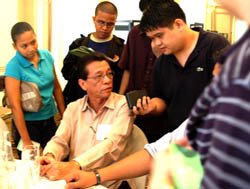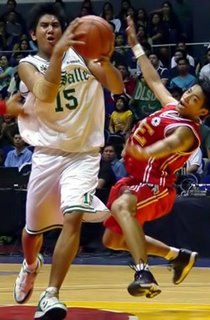
WHEN THE DLSU administration found two Green Archers ineligible to play due to spurious documents, it directly distributed its press statements among the print and TV media – the supposed purveyors of truth and watchdogs of the society.
In the past months, there has been a non-stop onslaught if media stories regarding the issue, which what media is described as “doing their job”. Although today, the topic on eligibility case has been silenced because most likely, the media has already exhausted all possible angles.
The one thing they could take out and be better off with: media sensationalism.
According to Webster, sensationalism is defined as “to cast and present in a manner intended to arouse strong interest, especially through inclusion of exaggerated or lurid details.”
As a contemporary trend in reporting, news is “sensationalized” so as to have commercial gains whether directly or indirectly. Those “lurid details” can be anything from exaggerated figures or incomplete quotes that totally change how the audience views a certain piece of information that produces different implications.
What’s the word, that’s the word

For instance, in reporting on a story about a UAAP board meeting, the Philippine Star had the article’s title as "UAAP Junks DLSU report”, while the Philippine Daily Inquirer as “UAAP to probe deeper into La Salle eligibility case”, and The Manila Bulletin as “UAAP finds La Salle report shallow, orders own probe” as the story’s title.
The articles came out on November 9 to 10, and reported how the UAAP Board convened and was unsatisfied with how the rather short report of the findings submitted by DLSU officials. Thus, the Board decided to form its own fact-finding committee to reach a conclusive verdict. Now when the details come in, so did the differences too.
Judging by the titles alone, it would seem that “UAAP Junks DLSU report” would have greater impact than the other news articles. Looking deeper into the articles, the first one using “junk” as a verb makes it weigh heavier than the other two and attracts more attention because of the word usage.
In contrast, the Inquirer article implies a milder decision claiming that, “Calling La Salle’s report a bit shallow, the UAAP Board formed its own fact-finding committee yesterday to probe deeper into the eligibility case involving two Green Archers.”
Furthermore, the quotes from the press conference vary. In the Bulletin article, Rendon, the UAAP President, was quoted with saying, “The report should have been much deeper, but what they (La Salle officials) gave us was much too shallow.”
While in the Inquirer article, he was quoted with saying, “It was a bit shallow. Did it just end there, Lacson and assistant team manager Manny Salgado? After they denied everything, what now?” It would appear in the Bulletin article that Rendon found the report “too” shallow, while in the Inquirer article, it was just “a bit” shallow.
The Philippine Star’s article never made mention on “shallowness”. The articles also led to different endings and different implications. The Philippine Star’s article ended with Matibag (UAAP secretary-general) saying, “Then we will have to decide if it’s time to award it to FEU.”
While the Bulletin article ended with Cardona cleared of “wrongdoing” and Matibag assuring that DLSU will continue to complete in the second semester UAAP events.
What is the truth? It would appear that reading the articles side by side posted more questions than facts in the end.
Jigsaw Puzzle
 A few months ago, or might we say before the UAAP season ended, the University was viewed highly by the media because of its strong call for President Gloria Arroyo to “make the supreme sacrifice”, when all of a sudden it became a 180 degree turnabout for the entire view on the University because of the controversy.
A few months ago, or might we say before the UAAP season ended, the University was viewed highly by the media because of its strong call for President Gloria Arroyo to “make the supreme sacrifice”, when all of a sudden it became a 180 degree turnabout for the entire view on the University because of the controversy.No more championship talks or good education. Haven’t people heard and read the same words a few months ago? The ineligibility issue must be the sports pages’ equivalent of the Gloria-gate scandal.
The negative reaction of certain alumni and opinionated mediamen don’t necessarily reflect the sentiments of the general public, but their opinions without objectivity reflect the over generalization arguments.
Philip Tangco, a DLSU alumnus, reacted, “Our media has deteriorated to become an instrument for manipulation, power brokering, and profit making. Rather than, and shamelessly contrary to their self-claim to be purveyors of truth, there was one “report” that DLSU merely disclosed the eligibility issue to preempt other sources from revealing it first…”
Unimpeachable reporting
 Last year, when the media heard from unconfirmed sources that a certain hostage in Iraq was to be released, viewers were made to believe that he was really free and everybody tuned in to the newscasts in vain.
Last year, when the media heard from unconfirmed sources that a certain hostage in Iraq was to be released, viewers were made to believe that he was really free and everybody tuned in to the newscasts in vain.Likewise, Br. Armin told The Lasallian that there seems to be a mole inside DLSU, who have been feeding sources to the media, which they refer to as “unimpeachable source”. In fact, the administrators never released a press statement regarding the resignation of Br. Bobby and Edwin Santiago, but the story was published in Inquirer. Curiously, it was only the Inquirer which had the exclusive story that day.
An administrator commented that the sports journalists have been playing with the press releases of DLSU with regard to the issue, changing the contexts of the press statement. Context is vital to the substance and the interpretation of the news article as it is always assumed that the reader is not familiar with the background of the story.
With the scandal, DLSU’s statements made it clear that neither the Administration nor Department of Education knew of the spurious documents until the University officials asked for verification. However, the media highlighted on the supposed “cover up” of DLSU during the UAAP season using quotes taken from such press statements.
Another good example is the article “DLSU to endorse case to authorities” in The Philippine Star on Nov. 4 that stated, “It would endorse the findings of its four-man panel to the appropriate government agency, like the National Bureau of Investigation(NBI),” while on DLSU’s press statement, there is no mention of NBI, only “proper authorities.”
Media sensationalism was partially responsible for the University being branded such negatives and pointing fingers to athletes as if they were “criminals”. The University will absorb the hatred of their words through athletic losses, but the media aren’t helping anybody else but themselves.
Today, there aren’t many positive news stories on DLSU or other happenings in the campus; it is as if the scandal is the only thing happening around the school.
The ineligibility scandal is the current “saga” in news sensationalism, but the national journalists should find more ways to report the issue rather than twist the truth behind the story. They can start by rebuilding the school’s reputation and reporting on how badly they have handled the issue thus far. After all, the objective of news is to search the “truth” and not to sugarcoat it.




